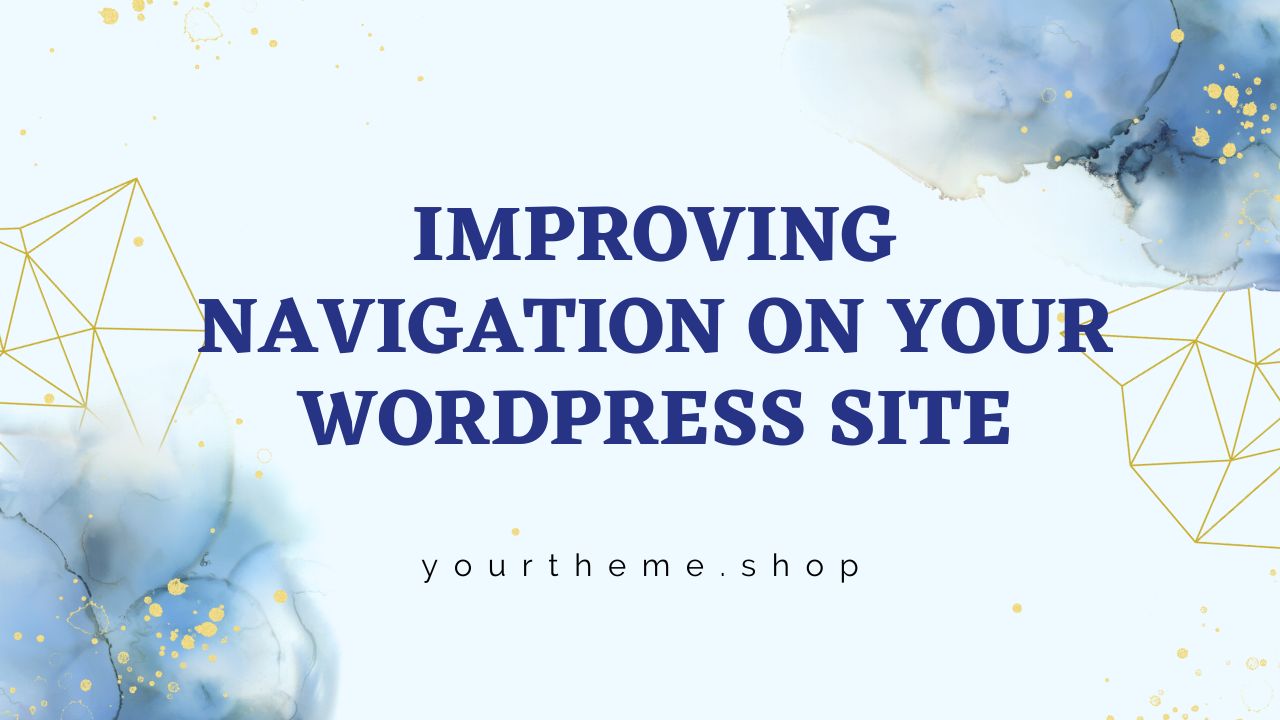Improving Navigation on Your WordPress Site
The Importance of Effective Navigation
Improving navigation on your WordPress site not only enhances the user experience but also contributes significantly to the site’s overall performance. A well-structured navigation setup guides visitors smoothly through your content, increasing the likelihood of achieving your website’s objectives, whether they’re related to e-commerce, information dissemination, or community building.
Overview of WordPress Navigation Features
Customizable Menus: A Core Feature for Improving Navigation on Your WordPress Site
Understanding Menu Types
WordPress offers a variety of menu types, each serving different navigation needs. From primary menus that guide users through your site to secondary menus for additional information, the flexibility is key in enhancing user experience with WordPress site navigation.
Tailoring Menus to Your Needs
The ability to tailor menus according to your site’s structure is crucial. WordPress menu customization for better navigation allows you to create menus that reflect the content and hierarchy of your site, making it easier for users to find what they need.
Widgets and Plugins: Enhancing User Experience with WordPress Site Navigation
Navigation Widgets
Widgets in WordPress add functionality to your site’s sidebars and footers. They can be used to display recent posts, categories, or even custom menus, contributing to simplifying navigation on your WordPress website.
Plugins for Advanced Navigation
Plugins extend the capabilities of WordPress menus. From mega menus to responsive, mobile-friendly navigation bars, these tools are instrumental in improving navigation on your WordPress site. They offer solutions for complex sites where standard menus might fall short.
Responsive Design: Key to Simplifying Navigation on Your WordPress Website
Mobile-Friendly Navigation
With the increasing use of mobile devices, ensuring your WordPress site’s navigation is responsive is non-negotiable. Menus should adapt to different screen sizes, maintaining usability and enhancing user experience on all devices.
Touchscreen Readiness
Incorporating touchscreen-friendly navigation elements is another aspect of responsive design. This includes easy-to-tap menu items and swipeable elements, crucial for simplifying navigation on your WordPress website for mobile users.
Accessibility: A Pillar in Enhancing User Experience with WordPress Site Navigation
Keyboard Navigation
Ensuring your site’s navigation is accessible via keyboard is essential for users who cannot use a mouse. This aspect of WordPress menu customization for better navigation makes your site more inclusive and user-friendly.
Screen Reader Compatibility
Screen reader compatibility is vital for visually impaired users. Properly structured menus with clear, descriptive labels help these users navigate your site effectively, enhancing user experience with WordPress site navigation.
SEO-Friendly Navigation: Boosting Your Site’s Visibility
Clean, Organized Structure
A well-organized menu structure not only aids users but also search engines. Simplifying navigation on your WordPress website with a clean, logical menu layout improves crawlability, impacting your site’s SEO positively.
Using Keywords in Menus
Incorporating relevant keywords into your menu items can aid in improving navigation on your WordPress site from an SEO perspective. This practice helps search engines understand the context of your pages, potentially boosting your rankings.
User-Centric Design: The Heart of WordPress Navigation
Intuitive Layout
An intuitive layout is key in enhancing user experience with WordPress site navigation. Menus should be arranged logically, with the most important items placed prominently.
Consistent Design Across Pages
Consistency in menu design across all pages aids in simplifying navigation on your WordPress website. Users feel more comfortable and find it easier to navigate when the design and layout are familiar.
Strategies for Improving WordPress Navigation
Analyzing User Behavior for Navigation Optimization
Understanding how visitors interact with your site is the first step in enhancing user experience with WordPress site navigation. Tools like Google Analytics provide insights into which pages are most visited and the typical paths users take, helping you optimize the navigation structure.
Best Practices in Menu Design and Layout
A well-designed menu is a cornerstone of effective site navigation. It should be concise yet comprehensive, reflecting the site’s hierarchy in an intuitive manner. WordPress menu customization for better navigation involves grouping related items and using descriptive labels that resonate with the user’s search intent.
Customizing Menus for Enhanced User Experience
Step-by-Step Guide to WordPress Menu Customization
- Access the WordPress Dashboard: Navigate to ‘Appearance’ and then ‘Menus’.
- Create a New Menu: Click on ‘create a new menu’, name it for easy identification.
- Add Menu Items: Select pages, categories, or custom links from the left panel and add them to your menu.
- Organize the Structure: Drag and drop the items to arrange them. Sub-items can be created for dropdown menus.
- Configure Menu Settings: Select display locations and other settings, then save your menu.
Tips for Creating Responsive and Accessible Menus
Ensure your menus are responsive, adapting seamlessly to different devices. Accessibility is also key; use clear, readable fonts and consider those with impairments by adhering to web accessibility standards.
Simplifying Your WordPress Website Navigation
Techniques for Streamlining Navigation
Simplifying navigation on your WordPress website involves decluttering the menu, removing redundant or less important links, and ensuring a logical flow. A simpler navigation structure enhances usability and improves the overall aesthetic of the site.
Balancing Simplicity with Functionality
While simplicity is important, it’s crucial to balance it with the functionality of your site. Every menu item should serve a purpose, contributing to the user’s journey through your site.
Advanced WordPress Navigation Tools and Plugins
Top Plugins for Navigation Enhancement
Plugins like ‘Max Mega Menu’ or ‘WP Responsive Menu’ can transform your basic menus into dynamic, feature-rich navigation panels. These tools offer greater control and customization options, aligning with various design needs.
Integrating Third-Party Tools for Improved Navigation
Incorporating third-party tools can further enhance navigation. Tools like ‘UberMenu’ or ‘Breadcrumb NavXT’ add advanced features like mega menus or breadcrumb trails, respectively, improving the overall navigation experience.
Designing for Different Types of Websites
E-commerce Site Navigation Best Practices
For e-commerce sites, clear and intuitive navigation is vital. Categories should be well-defined, and search functionality should be prominently placed to facilitate quick product discovery.
Blog and Portfolio Navigation Strategies
Blogs and portfolios benefit from a more streamlined navigation approach. Categories, tags, and a search bar are essential for helping visitors find specific content or projects.
SEO Considerations for WordPress Navigation
Navigation Structure and Its Impact on SEO
A well-structured navigation is crucial for SEO. It helps search engines understand and index the site’s content efficiently. Enhancing user experience with WordPress site navigation also contributes to lower bounce rates and higher engagement, positively impacting SEO.
Optimizing Menus for Search Engines
Use relevant keywords in menu labels and ensure the navigation hierarchy mirrors the site’s content structure. This clarity aids search engines in understanding the site’s context, boosting its visibility in search results.
User Experience (UX) and Navigation
The Role of Navigation in UX
Navigation directly impacts UX by determining how easily users can find what they’re looking for. A frustrating navigation experience can deter users from engaging with your site, while a smooth one can enhance satisfaction and retention.
Gathering and Implementing User Feedback
Collecting user feedback on navigation can provide valuable insights. Tools like heatmaps or user surveys can reveal areas for improvement, allowing for a more user-centric navigation design.
Troubleshooting Common Navigation Issues
Identifying and Resolving Navigation Problems
Common issues include broken links, confusing menu structures, or non-responsive design. Regularly reviewing and testing your site’s navigation helps identify and rectify these issues promptly.
Enhancing Navigation with User Testing
User testing is a powerful method for evaluating navigation effectiveness. Observing real users as they navigate your site can uncover hidden issues and preferences, guiding you in refining the navigation experience.
Case Studies: Successful WordPress Navigation Examples
Analysis of High-Performing WordPress Sites
Examining successful WordPress sites provides practical insights into effective navigation design. These case studies highlight the strategies and tools used to create user-friendly and SEO-optimized navigation structures.
Lessons Learned and Best Practices
Key lessons include the importance of a clear hierarchy, the balance between aesthetics and functionality, and the role of continuous testing and improvement in maintaining effective navigation.
Conclusion and Next Steps
Summarizing Key Takeaways
Effective site navigation is a blend of user-centric design, SEO best practices, and continuous improvement. WordPress offers extensive tools and plugins to create a navigation structure that enhances both user experience and site performance.
Planning for Continuous Navigation Improvement
Regularly reviewing your site’s navigation, staying updated with the latest trends and tools, and actively seeking user feedback are essential steps for ongoing navigation enhancement.
Elevate your WordPress site with enhanced navigation. A user-friendly, well-structured menu, responsive design, and SEO optimization are keys to success. Explore tools, strategies, and best practices for continuous improvement.


